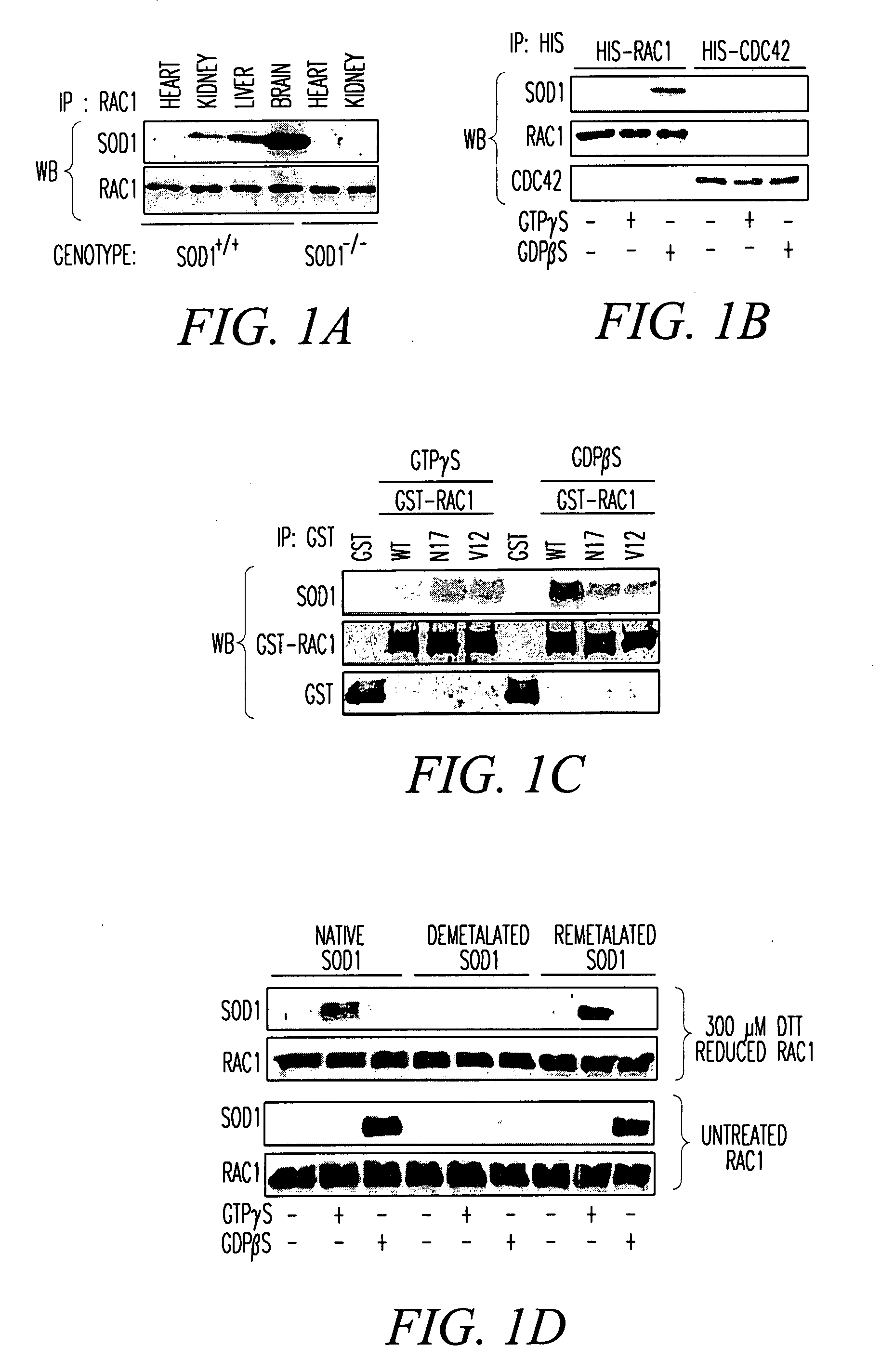Method of identifying compounds useful to treat neuronal degenerative diseases
a neurodegenerative disease and compound technology, applied in the field of compound identification, can solve the problems of poorly understood mechanisms by which cells maintain redox-homeostasis, and achieve the effects of inhibiting nadph, prolonging life, and delaying the onset of diseas
- Summary
- Abstract
- Description
- Claims
- Application Information
AI Technical Summary
Benefits of technology
Problems solved by technology
Method used
Image
Examples
example 1
SOD1 is a Redox Sensor for Rac 1-Mediated NADPH Oxidase Activation Materials and Methods
[0214]Materials. Cytochrome C, phorbol myristate acetate (PMA), GTP, GDP, xanthine, xanthine oxidase, imidazole cellulose PEI matrix TLC plates, Lucigenin, β-NADPH and E. coli superoxide dismutase were purchased from Sigma-Aldrich corporation (St. Louis, Mo.). Dulbecco's modified Eagle's medium (DMEM), penicillin / streptomycin (P / S), 0.25% trypsin-EDTA, fetal bovine serum (FBS), Amphotericin B and collagenase were purchased from Invitrogen Corporation (Carlsbad, Calif.). Radioactive nucleotides, liquid scintillation fluid, Dextran 500 and nitrocellulose protein transfer membrane were purchased from Amersham Biosciences (Piscataway, N.J.). Protease inhibitor cocktail (PIC), EDTA-free PIC, GTPγS and GDPβS were purchased from Roche Applied Science (Indianapolis, Ind.). Histidine-tagged Rac1 (His-Rac1), His-Cdc42, Glutathione transferase-tagged (GST) p50-Rho-GAP catalytic domain (p29-GAP), GST-tagged ...
example 2
Materials and Methods
[0244]Recombinant expression vectors and siRNA. MCF-7 cells were infected with recombinant adenoviruses (500 particles / cell) as previously described and cells were utilized for experiments at 48 hours post-infection. Lipofectamine™ 2000 (Invitrogen) was used for all plasmid transfections and cells were utilized for experiments at 48 hours post-transfection. The following E1-deleted recombinant adenoviral vectors were used: 1) Ad.GPx-1, which encodes glutathione peroxidase-1 and degrades cytoplasmic H2O2 (Duan et al., 1999); 2) Ad.Dyn(DN), which encodes a dominant-negative mutant (K44A) of dynamin and inhibits endocytosis (Li et al., 2001); 3) Ad.NFκBLuc, which encodes an NFκB-responsive promoter driving luciferase expression and was used to assess NFκB transcriptional activation in vivo (Sanglioglu et al., 2001); and 4) Ad.BglII, an empty vector with no insert, was used as a control for viral infection (Li et al., 2001). For NFκB transcriptional assays utilizing...
example 3
[0276]Recent studies using controlled expression of mutant SOD1 in motor neurons and microglia have demonstrated that these two cell types contribute to different phases of ALS disease progression, motor neurons in early phases of disease onset and microglia in later phase disease progression (Boillee et al., 2006). These findings implicate primary defects in microglial function as a consequence of mutant SOD1 expression. Hence, although increased numbers of spinal cord microglia in ALS likely enhance the potential for redox-mediated inflammatory damage, the mechanism by which mutant SOD1 alters microglial function and contributes to this inflammatory process remains unknown.
[0277]It was hypothesized that mutant SOD1 directly influences the ability of microglia to produce ROS. Given the fact that Nox2gp91phox has been shown to contribute to spinal cord redox-stress in mouse models of ALS (Wu et al., 2006), ALS SOD1 mutants may directly lead to dysregulation of Nox-derived superoxide...
PUM
| Property | Measurement | Unit |
|---|---|---|
| width | aaaaa | aaaaa |
| fluorescence resonance energy transfer assays | aaaaa | aaaaa |
| luminescence resonance energy transfer assays | aaaaa | aaaaa |
Abstract
Description
Claims
Application Information
 Login to View More
Login to View More - R&D
- Intellectual Property
- Life Sciences
- Materials
- Tech Scout
- Unparalleled Data Quality
- Higher Quality Content
- 60% Fewer Hallucinations
Browse by: Latest US Patents, China's latest patents, Technical Efficacy Thesaurus, Application Domain, Technology Topic, Popular Technical Reports.
© 2025 PatSnap. All rights reserved.Legal|Privacy policy|Modern Slavery Act Transparency Statement|Sitemap|About US| Contact US: help@patsnap.com



